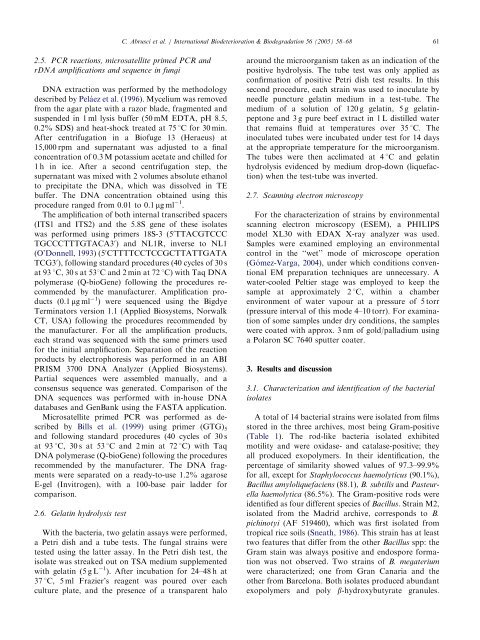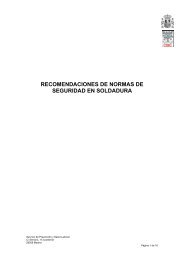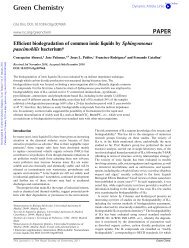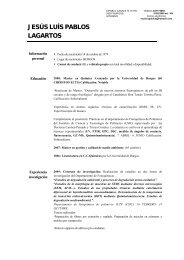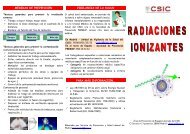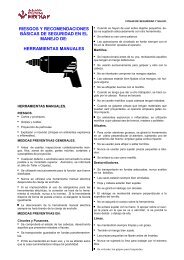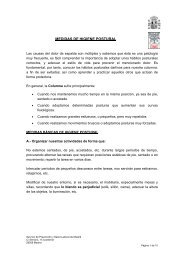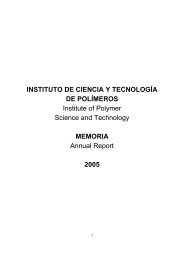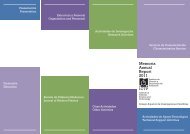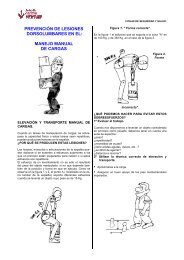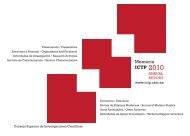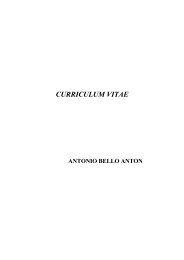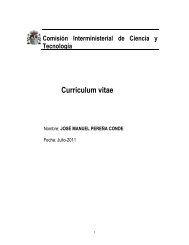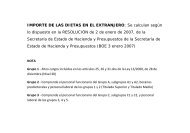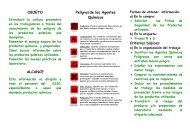Isolation and identification of bacteria and fungi from ... - ictp
Isolation and identification of bacteria and fungi from ... - ictp
Isolation and identification of bacteria and fungi from ... - ictp
- No tags were found...
Create successful ePaper yourself
Turn your PDF publications into a flip-book with our unique Google optimized e-Paper software.
ARTICLE IN PRESS<br />
C. Abrusci et al. / International Biodeterioration & Biodegradation 56 (2005) 58–68 61<br />
2.5. PCR reactions, microsatellite primed PCR <strong>and</strong><br />
rDNA amplifications <strong>and</strong> sequence in <strong>fungi</strong><br />
DNA extraction was performed by the methodology<br />
described by Pela´ ez et al.(1996).Mycelium was removed<br />
<strong>from</strong> the agar plate with a razor blade, fragmented <strong>and</strong><br />
suspended in 1 ml lysis buffer (50 mM EDTA, pH 8.5,<br />
0.2% SDS) <strong>and</strong> heat-shock treated at 75 1C for 30 min.<br />
After centrifugation in a Bi<strong>of</strong>uge 13 (Heraeus) at<br />
15,000 rpm <strong>and</strong> supernatant was adjusted to a final<br />
concentration <strong>of</strong> 0.3 M potassium acetate <strong>and</strong> chilled for<br />
1 h in ice.After a second centrifugation step, the<br />
supernatant was mixed with 2 volumes absolute ethanol<br />
to precipitate the DNA, which was dissolved in TE<br />
buffer.The DNA concentration obtained using this<br />
procedure ranged <strong>from</strong> 0.01 to 0.1 mgml<br />
1 .<br />
The amplification <strong>of</strong> both internal transcribed spacers<br />
(ITS1 <strong>and</strong> ITS2) <strong>and</strong> the 5.8S gene <strong>of</strong> these isolates<br />
was performed using primers 18S-3 (5 0 TTACGTCCC<br />
TGCCCTTTGTACA3 0 ) <strong>and</strong> NL1R, inverse to NL1<br />
(O’Donnell, 1993) (5 0 CTTTTCCTCCGCTTATTGATA<br />
TCG3 0 ), following st<strong>and</strong>ard procedures (40 cycles <strong>of</strong> 30 s<br />
at 93 1C, 30 s at 531C <strong>and</strong> 2 min at 72 1C) with Taq DNA<br />
polymerase (Q-bioGene) following the procedures recommended<br />
by the manufacturer.Amplification products<br />
(0.1 mgml<br />
1 ) were sequenced using the Bigdye<br />
Terminators version 1.1 (Applied Biosystems, Norwalk<br />
CT, USA) following the procedures recommended by<br />
the manufacturer.For all the amplification products,<br />
each str<strong>and</strong> was sequenced with the same primers used<br />
for the initial amplification.Separation <strong>of</strong> the reaction<br />
products by electrophoresis was performed in an ABI<br />
PRISM 3700 DNA Analyzer (Applied Biosystems).<br />
Partial sequences were assembled manually, <strong>and</strong> a<br />
consensus sequence was generated.Comparison <strong>of</strong> the<br />
DNA sequences was performed with in-house DNA<br />
databases <strong>and</strong> GenBank using the FASTA application.<br />
Microsatellite primed PCR was performed as described<br />
by Bills et al.(1999) using primer (GTG) 5<br />
<strong>and</strong> following st<strong>and</strong>ard procedures (40 cycles <strong>of</strong> 30 s<br />
at 93 1C, 30 s at 53 1C <strong>and</strong> 2 min at 72 1C) with Taq<br />
DNA polymerase (Q-bioGene) following the procedures<br />
recommended by the manufacturer.The DNA fragments<br />
were separated on a ready-to-use 1.2% agarose<br />
E-gel (Invitrogen), with a 100-base pair ladder for<br />
comparison.<br />
2.6. Gelatin hydrolysis test<br />
With the <strong>bacteria</strong>, two gelatin assays were performed,<br />
a Petri dish <strong>and</strong> a tube tests.The fungal strains were<br />
tested using the latter assay.In the Petri dish test, the<br />
isolate was streaked out on TSA medium supplemented<br />
with gelatin (5 g L 1 ).After incubation for 24–48 h at<br />
37 1C, 5 ml Frazier’s reagent was poured over each<br />
culture plate, <strong>and</strong> the presence <strong>of</strong> a transparent halo<br />
around the microorganism taken as an indication <strong>of</strong> the<br />
positive hydrolysis.The tube test was only applied as<br />
confirmation <strong>of</strong> positive Petri dish test results.In this<br />
second procedure, each strain was used to inoculate by<br />
needle puncture gelatin medium in a test-tube.The<br />
medium <strong>of</strong> a solution <strong>of</strong> 120 g gelatin, 5 g gelatinpeptone<br />
<strong>and</strong> 3 g pure beef extract in 1 L distilled water<br />
that remains fluid at temperatures over 35 1C.The<br />
inoculated tubes were incubated under test for 14 days<br />
at the appropriate temperature for the microorganism.<br />
The tubes were then acclimated at 4 1C <strong>and</strong> gelatin<br />
hydrolysis evidenced by medium drop-down (liquefaction)<br />
when the test-tube was inverted.<br />
2.7. Scanning electron microscopy<br />
For the characterization <strong>of</strong> strains by environmental<br />
scanning electron microscopy (ESEM), a PHILIPS<br />
model XL30 with EDAX X-ray analyzer was used.<br />
Samples were examined employing an environmental<br />
control in the ‘‘wet’’ mode <strong>of</strong> microscope operation<br />
(Go´ mez-Varga, 2004), under which conditions conventional<br />
EM preparation techniques are unnecessary.A<br />
water-cooled Peltier stage was employed to keep the<br />
sample at approximately 2 1C, within a chamber<br />
environment <strong>of</strong> water vapour at a pressure <strong>of</strong> 5 torr<br />
(pressure interval <strong>of</strong> this mode 4–10 torr).For examination<br />
<strong>of</strong> some samples under dry conditions, the samples<br />
were coated with approx.3 nm <strong>of</strong> gold/palladium using<br />
a Polaron SC 7640 sputter coater.<br />
3. Results <strong>and</strong> discussion<br />
3.1. Characterization <strong>and</strong> <strong>identification</strong> <strong>of</strong> the <strong>bacteria</strong>l<br />
isolates<br />
A total <strong>of</strong> 14 <strong>bacteria</strong>l strains were isolated <strong>from</strong> films<br />
stored in the three archives, most being Gram-positive<br />
(Table 1).The rod-like <strong>bacteria</strong> isolated exhibited<br />
motility <strong>and</strong> were oxidase- <strong>and</strong> catalase-positive; they<br />
all produced exopolymers.In their <strong>identification</strong>, the<br />
percentage <strong>of</strong> similarity showed values <strong>of</strong> 97.3–99.9%<br />
for all, except for Staphylococcus haemolyticus (90.1%),<br />
Bacillus amyloliquefaciens (88.1), B. subtilis <strong>and</strong> Pasteurella<br />
haemolytica (86.5%). The Gram-positive rods were<br />
identified as four different species <strong>of</strong> Bacillus.Strain M2,<br />
isolated <strong>from</strong> the Madrid archive, corresponds to B.<br />
pichinotyi (AF 519460), which was first isolated <strong>from</strong><br />
tropical rice soils (Sneath, 1986).This strain has at least<br />
two features that differ <strong>from</strong> the other Bacillus spp: the<br />
Gram stain was always positive <strong>and</strong> endospore formation<br />
was not observed.Two strains <strong>of</strong> B. megaterium<br />
were characterized; one <strong>from</strong> Gran Canaria <strong>and</strong> the<br />
other <strong>from</strong> Barcelona.Both isolates produced abundant<br />
exopolymers <strong>and</strong> poly b-hydroxybutyrate granules.


